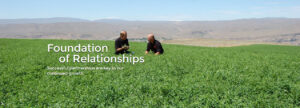Flaxseed Supplementation May Improve Equine Well-Being

Flax is an oilseed that is commonly grown in the northern Great Plains and Canada (1). It is an annual plant with slender, erect stems with pale blue (or sometimes red) flowers. Fibers from the flax plant have been used for centuries to create linen. Inside the flower is a fruit that contains flax seeds. These tiny seeds are commonly crushed to produce linseed oil, while the remaining flaxseed meal is often used as a protein supplement in livestock diets. Flax is an excellent source of protein, energy, and essential fatty acids (Table 1). In particular, flaxseeds and flaxseed oil are rich sources of alpha-linolenic acid, which is converted in the body to the omega-3 fatty acids – EPA (eicosapentaenoic acid) and DHA (docosahexanoic acid).
Equine diets generally contain more than adequate amounts of omega-6 fatty acids, but are limited in omega-3 fatty acids. Both of these essential fatty acids are important components of all cell membranes and can only be obtained through dietary sources (2). Omega-3 fatty acids reduce inflammatory responses, enhance immune function, and improve fertility (3). The only natural source of omega-3 fatty acids in the equine diet is fresh grass. Therefore, flaxseed is often added to equine diets to boost omega-3 intake. Supplements that contain flaxseed frequently claim to improve skin and hair coat quality, although there is limited scientific evidence to support these declarations. However, researchers at the University of Guelph in Ontario, Canada found that horses fed ground flaxseed had reduced reaction to an injection of extract from Culicoides, the insect (midges) that causes “sweet itch” in susceptible horses. In addition, results from a study conducted at Michigan State University (4) showed that horses fed omega-3 fatty acids tended to have longer stride lengths at the trot than when they were fed corn oil, suggesting that joint health may have been slightly improved with omega-3 supplementation. Feeding flaxseed may also help prevent sand and impaction colic because of its high fiber content.
Whole flaxseeds are not usually fed to horses because the tiny seed is hard to chew and most of it goes undigested if it is not processed before feeding. Most commercial forms of milled or ground flaxseed are stabilized to improve shelf life. In comparison, whole flaxseeds can be stored for an extended period of time. They should be ground immediately before feeding. Freshly ground flaxseeds go rancid rather quickly. If necessary, some can be stored in an air-tight container in the freezer for a few days; however, some nutrients will be lost. Be sure to clean the grinder thoroughly each day as small pieces left in the grinder can go rancid and spoil future batches.
Some have concerns about feeding flaxseeds to horses because they contain cyanogenic glycosides and enzymes, components that can interact and form cyanide. Because of the presence of these cyanide precursors, consumption of large quantities of flaxseed is thought to result in cyanide poisoning. For this reason, many horse owners boil flaxseeds for at least an hour prior to feeding to release cyanide. However, boiling conceivably destroys the fatty acids as well, so it would be preferable to skip this processing step, if possible. Fortunately, the horses used in the study at the University of Guelph had normal blood biochemical and hematological values and showed no other adverse effects after consuming non-boiled flaxseed meal for 42 days. The absence of toxicity in these horses suggests that the enzymes required to convert cyanogenic glycosides to cyanide are inactivated by stomach acids (2).
Flaxseed is a beneficial supplement for horses. It is high in protein and is an excellent source of energy and essential fatty acids. The high level of omega-3 fatty acid in flaxseeds may alleviate allergic skin conditions, improve immune function, and reduce inflammation. In addition, the high fat content of flaxseeds may help skinny horses gain weight, while the high fiber content may reduce incidence of colic. Evidence suggests that small amounts of flax can be fed safely to horses; however, concerns about processing flaxseeds prior to feeding should be directed to an equine nutritionist.
To receive this blog from Anderson Hay directly in your email, subscribe above to the right.
References
(1) Maddock, T.D., V.L. Anderson, and G.P. Lardy. 2005. Using flax in livestock diets. AS-1283. NDSU Extension Service, North Dakota Agricultural Experiment Station. North Dakota State University, Fargo, ND.
(2) O’Neill, W., S. McKee, and A.F. Clarke. 2002. Flaxseed (Linum usitatissimum) supplementation associated with reduced skin test lesional area in horses with Culicoides hypersensitivity. Can. J. Vet. Res. 66:272-277.
(3) Kentucky Equine Research, Inc. 2008. Omega-3 fatty acid supplementation provides significant benefits. http://www.ker.com/library/equinereview/2008/Nutrition/n41.pdf
(4) Woodward, A.D., B.D. Nielsen, C.I. O’Connor, C.D. Skelly, S.K. Webel, and M.W. Orth. 2007. Supplementation of dietary long-chain polyunsaturated omega-3 fatty acids high in docosahexaenoic acid (DHA) increases plasma DHA concentration and may increase trot stride lengths in horses. Equine and Comparative Exercise Physiology. 4:71-78.


